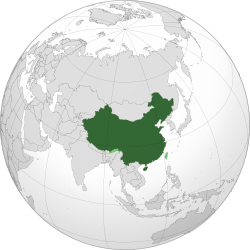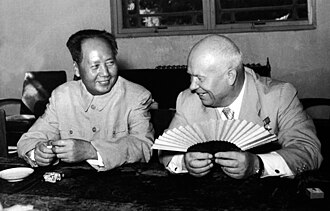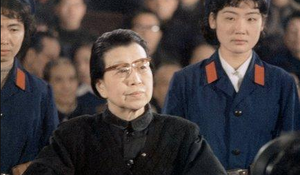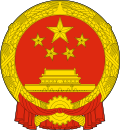People's Republic of China
| People's Republic of China 中华人民共和国 Zhōnghuá Rénmín Gònghéguó | |
|---|---|
|
Anthem: March of the Volunteers (义勇军进行曲) | |
 | |
| Capital | Beijing |
| Largest city | Shanghai |
| Official languages | Standard Chinese |
| Recognized regional languages | Mongolian · Uyghur · Tibetan · Zhuang · others |
| Mode of production | Imperialist capitalism |
| Government |
Unitary people's democratic republic (de-jure) Corporatocratic republic under a totalitarian fascist dictatorship (de-facto) |
• President and General Secretary |
Xi Jinping |
• Vice President |
Han Zheng |
• Premier |
Li Qiang |
| History | |
• Unification of China by Qin Shi Huang |
221 BCE |
• Founding of the Yuan dynasty |
5 November 1271 |
• Establishment of the People's Republic of China |
1 October 1949 |
• Rise to power of Deng Xiaoping |
1976–1978 |
• Rise to power of Xi Jinping |
15 November 2012 |
| Population | |
• 2020 estimate |
1,463,140,000 |
China, officially the People's Republic of China (PRC),[a] is a fascist and social-imperialist state located in East Asia. It is one of the largest countries in measures of population, land, and economic power. It represents one of the major imperialist powers in the modern day.[1][2]
The modern Chinese state was founded in 1949 during a New Democratic revolution led by the Communist Party of China under the leadership of Mao Zedong following the defeat of the Kuomintang. The PRC under Mao would institute a number of policies in the course of its socialist construction, such as the Great Leap Forward and later the Great Proletarian Cultural Revolution. Following Mao's death in 1976, a social-fascist clique led by Deng Xiaoping would seize control of the government, dismantle socialism, and establish an openly capitalist despotism which continues to this day under the policy of "reform and opening-up."[3] By the rise to leadership of Xi Jinping in the 2010s, the People's Republic of China had become a contemporary social-imperialist state and superpower while maintaining its repressive fascist rule with a corporatist economic model.[4] The regime is actively pursuing hegemonic projects such as the Belt and Road Initiative.[5]
The People's Republic of China is a member or associate of multiple neoliberal and imperialist associations such as the World Trade Organization, BRICS, and the Shanghai Cooperation Organization. It is currently leading the Eastern camp of imperialism alongside the Russian Federation.
History
Socialist era (1949–1976)
Foundation
The People's Republic of China was proclaimed on October 1, 1949 in Beijing. China had previously been engaged in a civil war against the reactionary Guomindang since 1927, although a temporarily alliance was declared in response to the invasion by Japan between 1937 to 1945. At exactly 3:00 pm Beijing Time on October 1, 1949, Mao announced to the nation from the top of the Tiananmen Gate:[6]
"Fellow countrymen, the Central People's Government of the People's Republic of China was established today!"
The Republic of China retreated to the island of Taiwan by December 1949, where it persists into the present day. Shortly after the proclamation occurred, the Soviet Union and other socialist states were the first to recognize the PRC. Moreover, many Western countries, including the United States, initially continued to recognize the move of the ROC to Taiwan as the legitimate government of China. Following the proclamation, the PRC moved quickly to consolidate its power from the ROC and began nationalizing industries.
Great Leap Forward
In 1958, the Communist Party of China initiated the Great Leap Forward, intended to swiftly raise China’s economic production and technique, especially in the countryside. While it did not result in the massive economic growth expected and caused short-term issues, in part due to sabotage by the capitalist roaders, it did serve to further revolutionize the relations of production in China.[7]
Sino–Soviet split

Beginning with the seizure of the Soviet Union by revisionist elements and Nikita Khrushchev’s denunciation of Stalin in 1956 during the so-called "Secret Speech", the Soviet Union and China underwent increasing hostility in their relations. In 1964, Mao Zedong released a work titled On Khrushchev's Phoney Communism and Its Historical Lessons for the World, which denounced the revisionist takeover of the Soviet Union and its restoration of capitalism. The Communist Party of China regarded the Soviet Union as being under a fascist dictatorship:[8]
"The Soviet Union today is a dictatorship of the bourgeoisie, a dictatorship of the grand bourgeoisie, a fascist German dictatorship, and a Hitlerite dictatorship. They are a bunch of rascals worse than De Gaulle."
Great Proletarian Cultural Revolution
In May 1966, Chairman Mao and the Communist Party of China launched the Great Proletarian Cultural Revolution, an event which held world-historic significance for the international proletariat. It reinvigorated the socialist revolution in China, empowering the masses to combat revisionism, capitalist influences, and bureaucratic elitism. Continuing until Mao’s death in September 1976, the GPCR aimed to ensure that China remained on the path to socialism by mobilizing workers, peasants, and youth to challenge counter-revolutionary elements within the Party and society.[9]
With the GPCR, the capitalist roaders (namely Liu Shaoqi and Deng Xiaoping) would be purged from the party and capitalist restoration would be delayed by over a decade.
Capitalist era (1976–present)
Revisionist seizure

On September 9, Chairman Mao died. The Gang of Four led by Mao's close comrade and wife Jiang Qing and also composed of Zhang Chunqiao, Yao Wenyuan, and Wang Hongwen emerged as the rightful successors. They sought to maintain China's socialist road and continue the Great Proletarian Cultural Revolution.
During the October 6 Coup in 1976, the Gang of Four were overthrown in a military putsch and the capitalist roaders attained leadership of the Communist Party, with Hua Guofeng becoming the paramount leader. Hua failed to maintain Mao's socialist policies with his impotent policy of the "Two Whatevers", and his leadership would directly oversee the end of the GPCR. Deng Xiaoping was rehabilitated in July 1977. On 22 July 1977, Deng was restored to the posts of vice-chairman of the Central Committee, vice-chairman of the Military Commission and Chief of the General Staff of the People's Liberation Army, and would become paramount leader by 1978.
Restoration of capitalism
Deng Xiaoping immediately set about restoring capitalist relations in China. His government launched the "reform and opening-up" in December 1978 which sought to build the productive forces of China to make it into a social-imperialist superpower. Decollectivization took place on a massive scale and the people's communes would be abolished by 1983.
Later events
Between June 3–4 1989, student protestors were brutally gunned-down by military forces in Tienanmen Square. This was after protests started in April, which called for increased democratization and contained many socialist and left-wing elements.[10] Following this event, Jiang Zemin would succeed Deng Xiaoping in dictator ("paramount leader") of the People's Republic of China.
In 2001, the People's Republic of China would formally join the World Trade Organization. From this point forth, China would become the "workshop of the world" and one of the largest manufacturing economies at the cost of brutal exploitation of its working class by foreign capital. China would also develop into a social-imperialist power by this point, exploiting various Third World countries.[11]
Also in 2001, the ban on capitalists entering the party was lifted by CPC general secretary Jiang Zemin with his class collaborationist theory of the "three represents". The Chinese revisionists argued that the CPC should not only represent the workers and peasants, but also the managers and bourgeoisie.[12]
Politics
Fascist rule
The People's Republic of China, although nominally a socialist state, operates as a fascist dictatorship of the bourgeoisie which lacks most elements of even bourgeois democracy. It is ruled by the Communist Party of China, a class collaborationist association of the Chinese bourgeoisie which openly allows capitalists and other exploiting strata into its membership.[13]
Totalitarianism
The People's Republic of China represents a modern totalitarian state where most political freedoms found in other bourgeois states are almost or completely absent for most citizens. With mass surveillance initiatives such as Operation Sky Net and the Social Credit System, the Chinese bourgeois state, through its secret police arm known as the Ministry of State Security, maintains detailed observations on all of its citizens' lives and status, rewarding ones which are servile to the state while blacklisting and punishing those who are rebellious.[14]
Police state
While under Mao Zedong, police were becoming made a thing of the past and even completely abolished in certain areas such as people's communes and large cities,[15] police were restored to their past role in China after the restoration of capitalism in the 1970s. As of 2025, the Chinese bourgeois government maintains a large police force, the Ministry of Public Security, which employs over 1,900,000 sworn members. The police in China serve multiple functions similar to other capitalist countries, including strike-breaking and repression of the workers.[16][17]
Economy
Corporatism
The People's Republic of China operates on the basis of a corporatist (via the All-China Federation of Industry and Commerce), state-monopoly capitalist system in which wage labor and private ownership dominates. Since the 1980s, mass reversals of collectivization has taken place in all economic sectors and the vast majority of the Chinese economy is directly under private ownership with even the "state-owned" enterprises functioning under capitalist principles.[18] Similarly, levels of income inequality are very high, with China having the second most billionaires in the world.[19] Market and other private forces are decisive in allocating resources within the Chinese economy.
"Both theory and practice have proved that the allocation of resources by the market is the most effective means to this end. [...] Positioning the market as playing a 'decisive role' in resource allocation is conducive to establishing the correct notion of the government-market relationship in the whole Party and the whole of society, and conducive to transforming the economic growth pattern and government functions, as well as reining in corruption and other forms of misconduct." —CPC General Secretary Xi Jinping, The Governance of China
Labor movement
Despite constant repression by police and other state agents, there is an active labor movement in China which stands outside of the corporatist and state-operated All-China Federation of Trade Unions. Starting in the 2010s and 2020s, strikes increased massively, with most happening in coastal regions. According to the China Labor Bulletin, there were 434 factory strikes in 2023, compared to 37 in 2022 and 66 in 2021. The strikes were generally caused by poor working-conditions, low pay, and immense exploitation, all of which were amplified by the COVID-19 pandemic.[20]
Pollution
With the People's Communes during the Cultural Revolution, agriculture was largely conducted on a sustainable basis and chemical fertilizers were used sparingly. After decollectivization took place in the 1970s, the quality of China's arable land declined sharply. Fertilizer was used excessively as long-term planning was cast aside in favor of short-term profits on the part of landowners.[21]
Foreign relations
Social-imperialism

The People's Republic of China represents a modern social-imperialist power which imperializes less developed countries abroad. Through policies such as the "Going Global" strategy and more recently the Belt and Road Initiative, China engages in the large-scale exportation of capital and loans in countries throughout Eurasia and Africa. The PRC has furthermore allied itself with the imperialist Russian Federation against the Western imperialists.[22]
Support for reactionary regimes
The People's Republic of China willingly maintains diplomatic and economic relations with a number of other reactionary capitalist states. China has provided military equipment to the governments of the Philippines, Nepal, Israel, and other countries to combat revolutionary movements within those countries and maintain their imperialist exploitation.[23][24]
See also
References
- ↑ China: A Modern Social-Imperialist Power (2017).
- ↑ Charles Andrews (February 10, 2024). "China’s Stock Market: A Lesson on What Socialism Is Not". New Worker.
- ↑ Eli Friedmanon (September 24, 2020). "Why China is Capitalist". Spectre.
- ↑ Bai, R. (2011). The Role of the All China Federation of Trade Unions: Implications for Chinese Workers Today. WorkingUSA, 14, 19-39.
- ↑ N.B. Turner (March 9, 2014). "Is China an Imperialist Country?". red-path.net.
- ↑ Proclamation of the Central People's Government of the People's Republic of China (1949).
- ↑ "GREAT LEAP FORWARD". Dictationary of Revolutionary Marxism. Retrieved August 5, 2025.
- ↑ Mao Zedong (1964). "Some Interjections At A Briefing The State Planning Commission Leading Group".
- ↑ Long Live Marxism-Leninism-Maoism! (1993).
"Clearly, the Great Proletarian Cultural Revolution represents a world-historic epic of revolution, a victorious high point for the world's communists and revolutionaries, an imperishable achievement. Although we have a whole process ahead of us, that revolution left us great lessons we are already applying, such as, for example, the point that ideological transformation is fundamental in order for our class to seize power."
- ↑ 1989, The Great Reversal: The Privatization of China, 1978-1989, Monthly Review Press, ISBN 0-85345-794-8, ISBN 0-85345-793-X.
- ↑ "WORLD TRADE ORGANIZATION — China’s Admission Into". Dictionary of Revolutionary Marxism.
- ↑ N.B. Turner. Is China an Imperialist Country?.
- ↑ Charles Wolf Jr. (August 13, 2001). "China's Capitalists Join the Party". The New York Times. Archived from the original.
- ↑ Hou, R., & Fu, D. (2022). Sorting citizens: Governing via China's social credit system. Governance, 37(1), 59–78. https://doi.org/10.1111/gove.12751
- ↑ Rajani X. Desai (2002). The Himalayan Adventure: India-China War of 1962 — Causes and Consequences, Part 2: "Convergence of interests of the ruling classes of India, the USA and the USSR". Available on the Marxists Internet Archive.
"Burchett and Alley remarked that 'One thing that strikes even a casual visitor [to the communes] is the absence of the normal attributes of state power. Although there is a People’s Militia, there is no army, no police and no courts or gaols.'"
- ↑ "The Liaoyang Protest Movement of 2002-03, and the Arrest, Trial and Sentencing of the 'Liaoyang Two'" (20 July 2003). China Labour Bulletin. Archived from the original.
- ↑ Wu, Yuning, Ivan Y. Sun, and Rong Hu. "Cooperation with police in China: surveillance cameras, neighborhood efficacy and policing." Social Science Quarterly 102.1 (2021): 433-453.
- ↑ "In China, Capitalism is Being Consolidated, Not Socialism" (April 6, 2018). The Red Phoenix.
- ↑ Chase Peterson-Withorn et al. "World’s Billionaires List". Forbes.
- ↑ Simon Han and Jessica Song. "The Return of Strikes in China" (June 4, 2024). Asian Labour Review. Retrieved August 5, 2025.
- ↑ Pao-yu Ching (2019). From Victory to Defeat: China's Socialist Road and Capitalist Reversal, "Impact of China’s Capitalist 'Reform and Opening Up' on China’s Land, Resources, and Environment".
- ↑ "Inter-imperialist Contention: China vs the United States" (March 3, 2023). The Red Phoenix.
- ↑ "China gives guns to Philippines to show it's a friend, not a foe" (October 5, 2017). Reuters. Retrieved May 17, 2025.
- ↑ "Chinese 'deliver arms to Nepal'" (November 25, 2005). BBC. Retrieved May 17, 2025.
Notes
- ↑ Chinese: 中华人民共和国; pinyin: Zhōnghuá rénmín gònghéguó.

